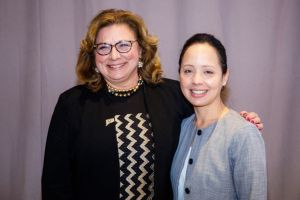
This month ATE Impacts 2018-2019: 25 Years of Advancing Technician Education rolls off the presses for mass distribution to centers and projects around the nation, and to attendees of the High Impact Technology Exchange Conference (HI-TEC) that begins July 25 in Miami.
The book showcases the work of the National Science Foundation’s Advanced Technological Education community and celebrates the 25th anniversary of the program. In addition to the summaries of ATE projects’ and centers’ activities and outcomes, the new book has an article that offers a snapshot of the ATE program’s influence on students’ careers.
The article features Karen Wosczyna-Birch, principal investigator and executive director of the ATE-funded Regional Center for Next Generation Manufacturing (RCNGM), discovering how the first ATE project grant she received nearly 20 years ago influenced the career of Hilda Arguelles, one of her students.
The two women reconnected at the 2018 Connecticut Technology Council Women of Innovation® Awards ceremony. Both women had been nominated as statewide innovators.
“As soon as I came into the room I heard her voice and I recognized her,” Arguelles said of the way she managed to find Wosczyna-Birch, her chemistry professor at Tunxis Community College, in a ballroom crowded with hundreds of people.
They hadn’t seen each other in more than 17 years, but Arguelles said Wosczyna-Birch’s words of encouragement had been so important to her as a young college student that she would recognize her voice anywhere.
On that day, March 28, 2018, both were finalists for the 2018 Connecticut Technology Council Women of Innovation Awards. At the time, Arguelles knew only that she was one of 16 finalists in the Large Business Innovation and Leadership category. She was happy to find out that Wosczyna-Birch was one of three finalists in the Academic Innovation & Leadership (Postsecondary) category.
When it was announced that Wosczyna-Birch won she was praised for “creating nationally recognized pathway programs between high schools, community colleges, and universities.” The pathway programs are a central feature of the programs RCNGM has developed with National Science Foundation support.
The award judges did not know it, but Arguelles was among the first students to participate in the first pathway program that Wosczyna-Birch developed in the late 1990s with support from an ATE project grant.
The success of that project Statewide College of Technology ATE Enhancement Project (DUE # 9950078) led to Wosczyna-Birch receiving ATE center grants and serving as the principal investigator of the Regional Center for Next Generation of Manufacturing (RCNGM). Under Wosczyna-Birch’s leadership since 2004 RCNGM has developed STEM career pathway programs across the state of Connecticut. Wosczyna-Birch is also director of Technology for the Connecticut State Colleges and Universities’ College of Technology.
That ATE project grant also propelled Arguelles’ career.
Arguelles’ mother taught elementary school and at home encouraged her children to ask questions. Arguelles said, “Science was always important in our house.”
But, Arguelles explained that when she was a young college student it was Wosczyna-Birch’s advice that kept her on track in the engineering associate degree program at Tunxis.
“She was always a very strong role model,” Arguelles said. She even quotes what Wosczyna-Birch said nearly 20 years ago: “She always said, ‘If there is one area where females could be earning just as much as men and the salary gap is closing, it is in technology.’ ”
Thanks to that ATE project another big, positive experience imprinted in her memory is the ATE Principal Investigators Conference. Arguelles had already transferred to the engineering program at Central Connecticut State University when Wosczyna-Birch asked her to attend the conference. Her role was to provide a student’s perspective on the career pathways that Wosczyna-Birch added to Tunxis chemistry courses with her ATE grant. In 2000 it was unusual for ATE principal investigators to include students in their presentations.
“Going to Washington was just a fabulous experience for a young person who was not really sure whether I was going to pursue a career in engineering,” Arguelles said. I addition to speaking during Wosczyna-Birch’s presentation she attended other conference sessions. All the educators talking about the outcomes of their ATE-funded activities stoked her excitement about a STEM career.
She graduated from CCSU’s engineering program that focused on composite and polymer materials. She later earned a master’s degree from Albertus Magnus College.
Pratt & Whitney hired her while she was still at CCSU through its Manufacturing Engineering Development program. She rotated through various departments at the company for two years. She then spent five years in manufacturing engineering followed by nine years as a mechanical design engineer.
Now she is senior manager of the Global Services Engineering team, which evaluates the effect that repairs have on the structural mechanical life of jet engine parts for commercial and military plane engines. As the manager and technical lead for a team of 12 engineers, she provides technical guidance and signature approval for critical repair decisions. The work she does every day is still connected to what she learned as an undergraduate. “Everything is based on science and math,” she said.
The informal mentoring that she provides to new women hired at Pratt & Whitney is another connection to Tunxis Community College, where she took her first two years of college courses to save money, and to Wosczyna-Birch, who she tries to emulate as a mentor.

 Subscribe
Subscribe


 See More ATE Impacts
See More ATE Impacts

Comments
There are no comments yet for this entry. Please Log In to post one.